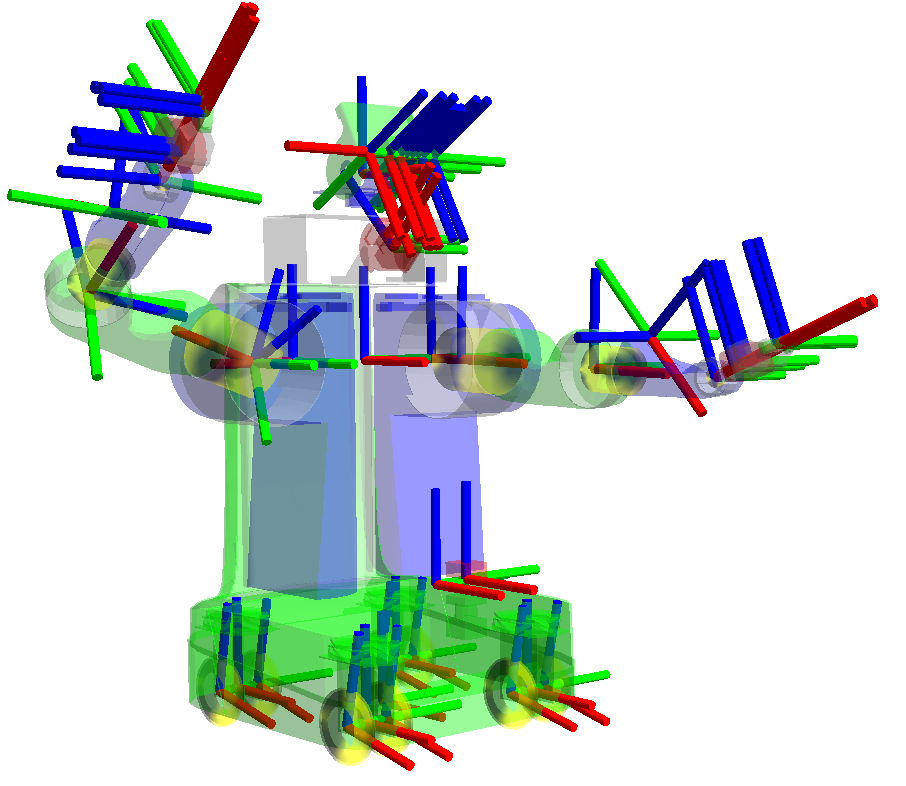| Note: This tutorial assumes you completed the create your own urdf file tutorial.. |
| |
Using the robot state publisher on your own robot
Description: This tutorial explains how you can publish the state of your robot to tf, using the robot state publisher.Tutorial Level: BEGINNER
Next Tutorial: For a detailed tutorial on how to use the robot_state_publisher in combination with a urdf, take a look at this tutorial
tf is deprecated in favor of tf2. tf2 provides a superset of the functionality of tf and is actually now the implementation under the hood. If you're just learning now it's strongly recommended to use the tf2/Tutorials instead.
Contents
When you are working with a robot that has many relevant frames, it becomes quite a task to publish them all to tf. The robot state publisher is a tool that will do this job for you.

The robot state publisher helps you to broadcast the state of your robot to the tf transform library. The robot state publisher internally has a kinematic model of the robot; so given the joint positions of the robot, the robot state publisher can compute and broadcast the 3D pose of each link in the robot.
You can use the robot state publisher as a standalone ROS node or as a library:
Running as a ROS node
robot_state_publisher
The easiest way to run the robot state publisher is as a node. For normal users, this is the recommended usage. You need two things to run the robot state publisher:
A urdf xml robot description loaded on the Parameter Server.
A source that publishes the joint positions as a sensor_msgs/JointState.
Please read the following sections on how to configure the parameters and topics for robot_state_publisher.
Subscribed topics
joint_states (sensor_msgs/JointState)
- joint position information
Parameters
robot_description (urdf map)
The urdf xml robot description. This is accessed via `urdf_model::initParam`
tf_prefix (string)
publish_frequency (double)
- Publish frequency of state publisher, default: 50Hz.
ignore_timestamp (bool)
- If true, ignore the publish_frequency and the timestamp of joint_states and publish a tf for each of the received joint_states. Default is "false".
use_tf_static (bool)
- Set whether to use the /tf_static latched static transform broadcaster. Default: false.
use_tf_static (bool)
- Set whether to use the /tf_static latched static transform broadcaster. Default: true.
Example launch file
Once you have setup the XML robot description and a source for joint position information, simply create a launch file like this one:
<launch>
<!-- Load the urdf into the parameter server. -->
<param name="my_robot_description" textfile="$(find mypackage)/urdf/robotmodel.xml"/>
<node pkg="robot_state_publisher" type="robot_state_publisher" name="rob_st_pub" >
<remap from="robot_description" to="my_robot_description" />
<remap from="joint_states" to="different_joint_states" />
</node>
</launch>
Running as a library
Advanced users can also run the robot state publisher as a library, from within their own C++ code. After you include the header:
#include <robot_state_publisher/robot_state_publisher.h>
all you need is the constructor which takes in a KDL tree
RobotStatePublisher(const KDL::Tree& tree);
and now, every time you want to publish the state of your robot, you call the publishTransforms functions:
// publish moving joints
void publishTransforms(const std::map<std::string, double>& joint_positions,
const ros::Time& time);
// publish fixed joints
void publishFixedTransforms();The first argument is a map with joint names and joint positions, and the second argument is the time at which the joint positions were recorded. It is okay if the map does not contain all the joint names. It is also okay if the map contains some joints names that are not part of the kinematic model. But note if you don't tell the joint state publisher about some of the joints in your kinematic model, then your tf tree will not be complete.







